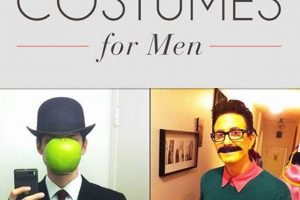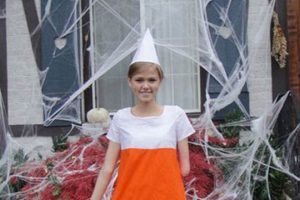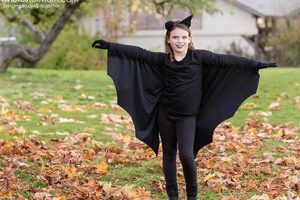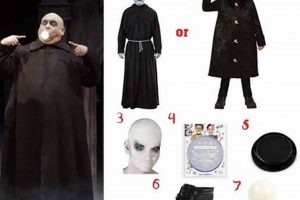Creating Norse warrior apparel offers an opportunity to fashion personalized garments reflecting historical or fantastical interpretations of Viking Age attire. This encompasses designing and constructing clothing, armor, and accessories suitable for cosplay, theatrical productions, or themed events. As an illustration, crafting a tunic from linen fabric, embellishing a leather belt with metal studs, and assembling a faux fur cloak would be consistent with this practice.
The advantage of undertaking this process lies in achieving cost-effectiveness, customized fitting, and creative control over the final appearance. Replicating historical details allows for deeper engagement with Norse culture. Individuals gain skills in sewing, leatherworking, and prop construction. The result is a distinctive and potentially more authentic representation than commercially available alternatives.
Subsequent discussion will focus on specific techniques, material selections, and construction methods relevant to fabricating various components of these ensembles, ranging from basic garments to elaborate armor and weaponry.
Essential Guidance for Norse Warrior Attire Construction
The subsequent guidelines provide crucial advice for those engaging in the self-directed creation of Viking-inspired garments and accessories. Diligence and informed decision-making are vital for authentic and satisfying results.
Tip 1: Research Historical Accuracy: Consult archaeological records, museum collections, and scholarly publications to ensure a degree of fidelity to Viking Age clothing styles and materials. Avoid relying solely on popular media portrayals, which may contain inaccuracies.
Tip 2: Prioritize Natural Fiber Fabrics: Linen, wool, and leather were prevalent materials. Opt for these whenever possible, as they offer a more authentic appearance and superior durability compared to synthetic alternatives.
Tip 3: Master Basic Sewing Techniques: A foundational understanding of hand-sewing and machine-sewing is essential. Practice simple stitches and seam finishes on scrap fabric before working on the final garment.
Tip 4: Acquire Appropriate Tools: Invest in quality sewing needles, shears, leather punches, and other necessary tools. The right equipment significantly improves the efficiency and precision of the construction process.
Tip 5: Plan the Design Carefully: Create detailed sketches and patterns before cutting any fabric or leather. This minimizes errors and ensures accurate sizing and proportions.
Tip 6: Incorporate Authentic Embellishments: Add details such as embroidery, tablet weaving, or metalwork to enhance the visual appeal and historical plausibility. Research traditional Norse motifs and techniques.
Tip 7: Focus on Functionality: Remember that Viking clothing was designed for practical use. Ensure that garments allow for freedom of movement and are suitable for the intended environment.
Adherence to these guidelines will facilitate the creation of convincing and durable Viking-themed attire, allowing for both aesthetic satisfaction and practical functionality.
The ensuing sections will delve into specific project ideas and provide further instruction on constructing various components of such attire.
1. Material Selection (noun)
Material selection is paramount in the endeavor of creating historically plausible Norse warrior attire. The choice of fabrics and components directly influences the garment’s appearance, durability, and overall impression of authenticity. Selecting materials aligned with historical evidence is pivotal for accurate representation.
- Fabric Type and Availability
The primary fabrics used during the Viking Age included linen and wool. Linen was favored for undergarments and lighter clothing, while wool provided warmth and durability for outer layers. Availability of these materials, and their varying grades, affects the construction process and the finished garment’s appearance.
- Color and Dyeing Techniques
Natural dyes were used to color fabrics, resulting in a palette of earthy tones. Replicating these colors, rather than using modern synthetic dyes, enhances the realism of the attire. Sourcing naturally dyed fabrics or employing historical dyeing methods contributes to authenticity.
- Leather and Hide Choices
Leather played a crucial role in belts, footwear, and armor components. The type of leather selected, whether tanned or raw, and the quality of the hide influence the longevity and appearance of these items. Choosing appropriate leather weights and finishes is essential for functional and aesthetically pleasing results.
- Metal and Ornamentation Components
Metal elements, such as buckles, rivets, and decorative studs, were integral to Viking Age attire. Selecting historically accurate metal types and finishes, such as bronze or iron, and employing reproduction ornamentation techniques enhances the overall authenticity. The choice of metal impacts both visual appeal and structural integrity.
These facets of material selection directly impact the fidelity and overall quality of a handcrafted Norse warrior costume. Careful consideration of historical accuracy, availability, and functional properties ensures that the resulting attire reflects the cultural and material realities of the Viking Age, producing more than a costume, and instead a historically informed wearable recreation.
2. Pattern Design (noun)
Pattern design constitutes a critical stage in the process of creating Norse warrior attire. It serves as the blueprint for transforming raw materials into wearable garments and accessories. The accuracy and suitability of pattern design directly impact the final product’s fit, appearance, and functional effectiveness. A poorly designed pattern results in ill-fitting, structurally unsound, and aesthetically unconvincing reproductions. For instance, creating a tunic without properly accounting for shoulder slope or armhole depth will inevitably lead to discomfort and an inaccurate silhouette, deviating significantly from the intended historical aesthetic.
Successful pattern design within the context of Norse warrior apparel requires a blend of historical awareness and practical pattern-making skills. Historical garments often utilized simpler construction methods than modern tailoring, yet achieving an authentic appearance necessitates understanding these methods. Examples include the use of geometric shapes and minimal shaping techniques found in extant Viking Age clothing fragments. Furthermore, accurate patterns facilitate efficient material usage, minimizing waste and reducing costs. For example, designing patterns to interlock minimizes scr
ap fabric. Practical application involves scaling patterns to fit individual body measurements, accounting for fabric drape and seam allowances, and iteratively adjusting the design based on test garments. This ensures that the final product not only replicates the historical style but also provides a comfortable and functional fit.
In summary, pattern design is an indispensable component in the creation of Norse warrior attire. Accurate designs grounded in historical research and skillful execution are essential for achieving credible and wearable results. While challenges may arise in adapting historical techniques to modern body shapes and fabric properties, a thorough understanding of pattern design principles remains fundamental to successful reproduction and fulfilling the desired outcome.
3. Construction Techniques (noun)
Construction techniques are fundamental to the successful realization of a Norse warrior costume. The selection and application of specific construction methods directly influence the authenticity, durability, and overall aesthetic of the final garment or accessory.
- Seam Types and Finishes
Historical evidence suggests the use of simple seam types, such as the running stitch or the whip stitch, often finished by hand. The choice of seam and finishing method impacts the strength and longevity of the garment. Machine-sewn seams, while faster, may detract from the historical appearance unless carefully concealed or adapted.
- Pattern Drafting and Draping
The method of creating patterns significantly affects the fit and appearance of the costume. Accurate pattern drafting, based on historical evidence, requires knowledge of geometric construction techniques. Draping, an alternative method, involves manipulating fabric directly on a form to achieve the desired shape. This technique necessitates an understanding of fabric behavior and its interaction with the body.
- Leatherworking and Metalworking Skills
Norse warrior attire frequently incorporates leather and metal elements, such as belts, armor components, and decorative embellishments. Proficiency in leatherworking techniques, including cutting, stitching, and tooling, is crucial for creating durable and authentic-looking leather goods. Similarly, metalworking skills, such as riveting and shaping, are necessary for producing realistic metal components.
- Hand Sewing and Embellishment Techniques
Hand sewing was a prevalent technique during the Viking Age. Mastery of various hand stitches, including the back stitch, blanket stitch, and decorative embroidery stitches, is essential for replicating historical detailing. Embellishment techniques, such as tablet weaving and naalbinding, add visual interest and authenticity to the costume.
These construction techniques collectively shape the creation of Norse warrior attire. Their skillful application ensures that the final product embodies the characteristics of Viking Age clothing, combining both functionality and aesthetic accuracy. Consideration of these techniques throughout the construction process results in more compelling and credible representations.
4. Authentic Embellishments (noun)
The incorporation of authentic embellishments is crucial to elevating a self-constructed Norse warrior costume beyond a mere costume and towards a historically informed representation. The attention to detail conferred by such embellishments substantially enhances the visual credibility and cultural resonance of the finished product.
- Tablet Weaving and Braiding
Tablet weaving, a technique involving the creation of narrow bands of intricately patterned fabric, was employed to adorn garment edges and belts. Examples from archaeological finds showcase complex geometric designs and color combinations. When creating Norse warrior attire, employing tablet-woven trims accurately reflects historical practices and adds a distinctive visual element. Replicating traditional patterns and color schemes ensures fidelity to the Viking Age aesthetic.
- Embroidery and Needlework
Embroidery served as a means of embellishing garments with decorative motifs and narrative scenes. Fragments of embroidered textiles reveal the use of various stitches and designs, often incorporating animal and geometric patterns. The application of historically accurate embroidery techniques, utilizing natural dyes and linen threads, significantly enhances the visual impact of a self-made costume. Embroidery can be used to personalize a garment while maintaining its historical integrity.
- Metalwork and Jewelry
Metal fittings, such as brooches, belt buckles, and pendants, were integral components of Viking Age attire. These items were often crafted from bronze, silver, or gold and adorned with intricate designs. Replicating these metal elements, either through reproduction jewelry or handcrafted metalwork, contributes to the overall authenticity of a self-constructed costume. The selection of historically accurate metal types and design motifs is essential for creating a convincing impression.
- Fur and Animal Hide Accents
Fur and animal hides were used to provide warmth and visual texture to clothing. Garments were often trimmed with fur or lined with animal hides, particularly in colder climates. Incorporating these materials into a Norse warrior costume can enhance its perceived authenticity and create a more visually striking appearance. Ethical sourcing of these materials and accurate representation of historical usage patterns are crucial considerations.
The diligent integration of these authentic embellishments transforms a self-assembled Viking-themed costume into a detailed representation of Norse attire. These techniques and materials not only elevate the visual impact but also serve as a tangible link to the past, providing a deeper understanding and appreciation of Viking Age craftsmanship. The strategic and informed application of embellishments signifies the difference between a generic costume and a well-researched historical interpretation.
5. Historical Research (noun)
Historical research constitutes the bedrock upon which accurate and credible Norse warrior attire projects are built. It directly influences material selection, pattern design, construction techniques, and the application of authentic embellishments. Neglecting historical research leads to inaccurate representations, perpetuating misconceptions about Viking Age clothing and culture. Conversely, thorough research allows creators to make informed decisions, ensuring that the resulting attire reflects the known facts and interpretations derived from archaeological evidence, historical texts, and scholarly analyses. For example, examination of extant textile fragments reveals the prevalence of specific weave structures and dye colors, guiding the selection of appropriate materials for a reconstruction.
The practical significance of historical research exten
ds beyond mere aesthetic considerations. Understanding the functional requirements of Viking Age clothing, such as its ability to provide warmth and protection, informs the selection of appropriate materials and construction methods. Analysis of burial finds, such as those at Birka in Sweden, reveals details about garment construction and adornment, providing valuable insights for pattern design and embellishment. Moreover, historical research can illuminate the social and cultural context of clothing, revealing information about status, occupation, and regional variations. The Oseberg tapestry fragments, for instance, showcase elaborate textile arts, offering inspiration for intricate embroidery or tablet weaving designs.
In conclusion, historical research is not merely an optional component but an essential prerequisite for any serious undertaking involving the creation of Norse warrior attire. While challenges exist in interpreting fragmentary evidence and reconciling conflicting sources, the benefits of diligent research far outweigh the difficulties. This knowledge empowers the creation of attire that reflects the tangible and intangible aspects of Viking Age society, enhancing authenticity and promoting a deeper appreciation of this historical era. It links the crafted costume to the rich context of its historical origins.
Frequently Asked Questions
This section addresses common inquiries concerning the creation of historically influenced Norse warrior attire. The provided answers are based on archaeological evidence, scholarly interpretations, and established construction practices.
Question 1: How crucial is it to adhere strictly to historical accuracy when creating Norse warrior attire?
Adherence to historical accuracy depends on the project’s objective. For educational or museum purposes, meticulous adherence is essential. For recreational use, a balance between historical plausibility and personal preference is acceptable.
Question 2: What are the most common errors to avoid when embarking on this project?
Common errors include using synthetic fabrics, relying on inaccurate pop culture portrayals, and neglecting historical construction techniques. Insufficient research often leads to anachronistic details.
Question 3: Is it necessary to be proficient in all historical crafts, such as tablet weaving and metalworking?
Complete proficiency in all crafts is not mandatory. However, acquiring basic skills or outsourcing specialized tasks to experienced artisans enhances the authenticity and quality of the attire.
Question 4: What are the essential resources for researching historical Norse clothing?
Essential resources include archaeological reports, museum collections, academic publications, and reputable historical reenactment societies. Consult multiple sources to ensure a comprehensive understanding.
Question 5: How can authenticity be achieved on a limited budget?
Authenticity can be achieved by focusing on essential details, utilizing natural materials, and employing simple construction techniques. Prioritizing key components and researching cost-effective alternatives is advisable.
Question 6: What are the considerations for adapting historical patterns to modern body shapes?
Adapting historical patterns requires careful consideration of body measurements and fabric drape. Adjustments should be made while maintaining the overall silhouette and construction principles of the original design.
Successful creation of Norse warrior attire necessitates a balance between historical knowledge, practical skills, and personal creativity. Diligent research, careful planning, and attention to detail are key factors.
The subsequent section will explore specific project examples, offering practical guidance on replicating various Norse warrior garments and accessories.
Conclusion
The preceding exploration of “vikings costumes diy” has underscored the critical elements necessary for constructing historically plausible Norse warrior attire. The importance of rigorous research, meticulous material selection, and skillful application of construction techniques cannot be overstated. Authentic embellishments further refine the representation, enhancing the costume’s visual impact and cultural relevance.
The creation of such attire represents more than mere fabrication; it serves as an engagement with history, demanding precision and dedication. The pursuit of historically informed Norse warrior attire necessitates a commitment to detail and a respect for the cultural heritage it seeks to represent. The result is a tangible link to the past, offering a deeper understanding and appreciation of the Viking Age.







